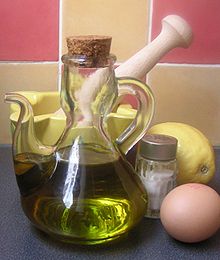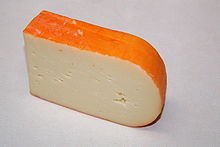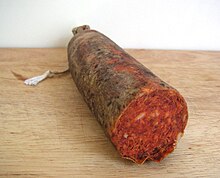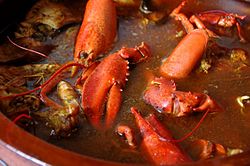Cuisine of Menorca

Minorcan cuisine refers to the typical food and drink of Minorca.
Minorca is a rocky island in the Balearic archipelago in Spain, consisting of eight municipalities. Featuring a Mediterranean climate, the weather is milder in the south while in the north there are strong winds all year round. Marine salt, carried by the wind to the pastures where cows graze, is what gives the cheese its typical flavour. Fish is a certain source of food, but additionally there are horses, pigs (used for cold cuts) and cows (the skin of which is used to produce leather, and the milk to produce cheese). Agriculture is small-scale and varied, consisting of typical Mediterranean products. Within this typical Mediterranean cuisine there are also the influences of various invading people, particularly the English, who brought plum cake, puddings, and punch. The rural and marine cuisine is mostly based on greens and vegetables from one's own garden, locally-produced meat, and fish and seafood caught in the same day. Cold cuts are used as seasoning. Olive oil, although not produced on the island, is also a fundamental ingredient in local dishes.
Minorcan cuisine is at times a survival cuisine, which preserves the original flavour of its high-quality products to the maximum. It is simple, with few complications, and above all seasonal. It is based on fishing, particularly longline fishing, and on seafood, especially crustaceans, clams and squid. Fruits and vegetables are cultivated in as much variety as possible, and on a small scale, only for local consumption.
Until the second half of the twentieth century, goats were in such abundance that they were only eaten when there was a famine, caused by spoiled crops or insufficient fishing. Today, they are a luxury. The legs of Minorcan kids are particularly appreciated.
There were so many rabbits on the island that Roman emperor Augustus had to send ferrets to help with hunting them; for this reason, rabbit is a common element of the cuisine. In later times, there were periods when hunting them was forbidden. In the seventeenth century, The English unsuccessfully attempted to introduce deer and hares. Few are left nowadays, but rabbits and various fowl are still hunted or bred.
General Aspects
The recipes and ways of Minorcan cuisine have been mostly transmitted through oral tradition, as opposed to Catalonia, for example, where recipe books can be found even from the Middle Ages. In Minorca, the first written mentions of its cuisine are only found in 1891, in some notes belonging to Archduke Ludwig Salvator of Austria, who references some typical cooking but without any recipes. There is nothing else until 1923, when De re cibaria, by Pedro Ballester, is published, a "major work" that collects a substantial part of popular wisdom and offers detailed anonymous recipes, which nevertheless require prior knowledge of local cuisine in order to be interpreted.
Minorcan cuisine is based on local products, from land or sea. Classic Mediterranean crops had a strong influence, encouraging the use of olive oil, wine, legumes and foods pickled in salt. The substratum of Arab culture is also important, as well as additions from French and English cuisine in particular, owing to their respective periods of domination in the eighteenth century.
Being a small island meant that the region passed through periods of scarcity, for various reaons, yet very flavourful dishes were still created despite also being very modest. Simpler versions of dishes that once belonged only to a minority were created, that were now accessible to everyone, under any circumstances. This is known as 'survival cuisine', and it is not absolutely exclusive to the island. Even during times of abundance, it is believed that a dish containing superfluous ingredients is not necessarily better, but actually the opposite, and the simplicity of a cuisine that would normally be considered 'poor and rural' is more appreciated.
Even today, when most products can be obtained all year round, Minorca has a seasonal cuisine, with seasonal ingredients and recipes, which follows the cycles of nature and marked holidays, according to its traditions.
Basic Ingredients
- Fish: pearly razorfish, sheepsheads, stingrays (wings and liver), scorpionfish, groupers, goosefish, rock fish in general, and salted cod.
- Seafood: mussels, cockles, squid, cuttlefish, octopus, shrimp, scampi, lobster, crab, sea snails.
- Vegetables: vinetomatoes, onion, garlic, chili pepper, aubergine, courgette.
- Legumes: dry white string beans (called guixons on the island).
- Greens: chard, spinach, peas (called fesols on the island), cabbage.
- Fruits: figs, peaches, apricots, pears, grapes, oranges, lemons.
- Nuts: dates, almonds, pine nuts.
- Meat: chicken, rabbit, pork, beef, cold cuts.
- Mushrooms: saffron milk cap, Scotch bonnet, dry mushrooms.
- Other: olive oil, bread, honey, capers, wine, eggs, snails, ricotta, figat (similar to Spanish fig cake and meringue).
Specialties

Mayonnaise
Mayonnaise supposedly originates in the city of Mahón. According to this theory, this sauce - an emulsion of eggs and olive oil - became known as a consequence of the brief French occupation of the island, which would take it to France. According to a different theory, it was invented in a French town called Maiona, or perhaps Baiona. A third is based on the dislike of the French towards garlic. As they tasted the Minorcan aioli, the French asked for the garlic to be removed, which left them with a white sauce made of olive and eggs: mayonnaise. In any case, mayonnaise, with or without garlic, is a product of frequent use in the traditional cuisine of the island since ancient times, on its own or as an ingredient in dishes.
Mahón Cheese

A local cheese is produced in Minorca: Mahón cheese. It features Denominación de Origen Protegida (Protected Demonination of Origin). It is pressed instead of boiled, and has a characteristic orange colourm, a parallelepiped shape, and rounded corners. It is made and matured only in Minorca, according to tradition and to the norms of the DO. In 1985, the definitve form of the Denomination of Origin was given as queso Mahón, and later, in 1998, the word Menorca was added, making the full name Mahón-Menorca. There are four main varieties, according to maturation time: mild, semi-mature, mature and aged. Ricotta or fresh, high-quality cottage cheese is also made in the same dairy shops in Minorca, but it does not have a specific name and is not widely known, since it is consumed only locally.
Cold Cuts

With the exception of the sobrassada, the cold cuts made in Minorca are an evolution of the Roman legacy. Everything is made of pork. The slaughter of the pigs, usually undertaken in winter, is called porquejades or porquetjades. Blood is added as an ingredient to some of these products, which gives them a black colour.
Similarly to the cuisine of the Catalan Countries, the spices used are few and not very varied, but they are the ones that give each product a distinct personality, and makes them different and flavourul. The spices normally used are black pepper, white pepper, paprika (in sobrassada), anise, cinnamon and salt. Some also add other typical Mediterranean spices such as thyme, rosemary and oregano.


• White Botifarra, of grayish clear brown color, since it does not contain blood, it has the form of the ball that is used for the escudella. It is made up of meat and other parts of the pig and it is surrounded by a fine membrane. It is generally eaten cooked, usually fried.
Traditional dishes
Vegetables, legumes and greens





Minorcan cuisine is very Mediterranean, rich in vegetables of all types. The island has been very self-sufficient providing these type of fresh products, thus they have never gone missing, thanks to the farming activity as part of the economy even to this day, time in which the crops represent approximately half of the Minorcan territory. The salad, hanging, bouquet tomatoes, etc. ,and other green vegetables to prepare salads and stir fry stand out—onions, Italian green peppers, red pepper, garlic—, roman lettuce to prepare salads, Mediterranean green vegetables that are fried, stuffed or oven baked, like eggplant, that in Minorca is small and very white in its interior, a variety of the summer season that cannot be cultivated in a greenhouse, zucchini, that is prepared in a similar way, or the artichoke, that is also from a local variety, small, long, and purple colored, that is eaten mainly as a side dish, battered and fried, oven baked or in stews.
Fruits are also abundant, specially figs, that are also eaten in savoury dishes, like for example the oliaigua.
Local green vegetables are prepared a "thousand ways", some of the most common are the guixons, the habas, the lentils, and the chickpeas.
Mushrooms are very much appreciated, oven baked, fried, with or without sauce to accompany meats, and the wild asparagus, very appreciated in the oliaigua (local soup) or simply with a tortilla.
Olive oil is the grease that is used to cook these dishes and is also common in pastry, while olives themselves are appreciated in this cooking, just like local capers. Until a few decades ago there were hundreds of olive trees in Minorca but nowadays these are not cultivated
Some Minorcan dishes that contain these ingredients are:
- Oven baked eggplant: a species of local eggplant is used that is smaller and more tender, they are thinly laminated and oven baked in a single layer, covered in shredded bread, with minced garlic and basil. It is similar to the carbassonada, made with zucchini instead of eggplant, and usually has chopped onion and is eaten in the other Balearic Islands. Oven baked tomates and stuffed zucchini are also traditional.
- Oliaigua, which in its origin was the scantiest soup, food for when you were lacking ingredients. It is usually eaten with figs during the summer.
- Perol, consists of a layer of laminated potatoes, another of laminated tomatoes, covered with shredded bread, garlic, basil and grilled. You can add fish- gilt-head bream or striped red mullet, for example, in between the layers of potatoes and tomatoes.
- Cuttlefish with fesols is a stew with fresh cuttlefish and peas, it is very common that is also traditionally served as a tapa. Sometimes little balls of minced meat are added.
A lot of salty products are made with wheat flour, many of which the bread dough often encircles the land's produce, like for example, the rubiols, the Minorcan flaons- salty pasta filled with cheese-, to the agujas or croissants- made with bread dough and shaped like a half moon- filled with sobrassada. The formatjades stand out, common in Easter time. The salty cocas are usually rectangular, open or closed, and can be traditionally filled with a stir-fry, vegetables or pepper, even though some have meat or fish. On Christmas eve it is common to eat, before the Midnight Mass, bread rolls filled with diced meat and soaked in milk and oven-cooked.

Fish and seafood
Sea products, for their insular condition, are widely consumed. Traditionally, Whitefish is used just the same- like for example, Goosefish or the Hake- like theOily fish- like the Atlantic mackerel or the sardine, for example-, very fresh, bought the same day it is fished. This type of cooking with fish is traditional because many Minorcans have a boat, in which they go fishing on weekends and in summer it was a customary, and it still happens, to go around the island on a boat, an excursion that forced you to eat the captured and cooked fish on board. The Scorpaena or scrofa, among them, is a highly appreciated and abundant fish. Another appreciated fish is the Rajiformes that can be oven-baked, grilled or in a paella.
A number of seafood, shells and mollusks are also used. These products, just like the earth products, change according to the season. They are cooked in pots or boilers, rice, and sometimes also in salty pies or puddings, oven-baked, grilled or in the oven. In Minorca there is a great tradition of eating varied fish, and even octopus or squid, in the form of meatballs. The cod ab burrida, that is prepared mixing cod sauce with garlic and oil dressing, is a dish that has the resemblance with others cooked in Catalonia, Provence, and other nearby areas.
Some Minorcan dishes with fish and seafood are:
- Stuffed calamari, oven baked or in a saucepan, its an elaboration that has been established in the Minorcan cookbook and has an established reputation for its subtlety of aromas.
- Lobster stew: until not long ago this type of sauce or bread soup was a poor fisher's dish, since Minorcan's lobsters were easy to find. Add bits of lobster on top of onions, tomato, garlic, and parsley and boil over high heat. Kaldereta is the best known internationally Minorcan dish, and of all the Minorcan pots the most emblematic is lobster. Other pots that are prepared a lot are made of fish, usually roca fish, like the grouper pot.
- Baked common cockle, covered with shredded bread, garlic, and parsley.
- Cabracho (scorpion fish) meatballs, with a sautéed and chopped sauce. Some put a little of grated Mahón cheese shredded in the meatballs, mixed with the fish. You can do it with other fish, for example, the ones used in soups. Meatballs in meat sauce are also prepared, which in this case contain pine nuts, it can be eaten as a tapa in bars and not only as a main dish.
Bebidas típicas
- Calent, bebida artesanal a la que se infusionan hierbas, canela, anís y azafrán, y que se bebe caliente o con hielo.
- Estomagale, bebida suave, con un sabor y textura muy particular.
- Frigola, es tomillo en Menorca. En las islas, es también un digestivo tradicional hecho con las flores del tomillo.
- Gin de Menorca, proviene de la presencia británica en la isla en el siglo XVIII. La destilería Xoriguer, que hace el conocido Gin Xoriguer, se encuentra en el puerto de Mahón.
- Licor de rosas, es un licor de origen griego que trajeron a la isla los trabajadores y comerciantes griegos en el siglo XVIII y que en Menorca se sirve en los bautizos.
- Pellofa, gin con piel de limón y un poco de sifón.
- Pomada, gin con limonada.
- Ratafía menorquina, se hace macerando durante ocho días aguardiente con hierbas de la isla, corteza de limón, nuez verde, clavel, nuez moscada y canela. También se hacen otros licores con manzanilla de Mahón, flor de naranjo o limonero, etc.
- Sengri, una especie de punch caliente con vino aromatizado, que data de la época de la presencia británica en el siglo XVIII. A pesar de la semejanza de la palabra, no tiene nada que ver con la sangría.
- El vino se cultiva en Menorca desde tiempos inmemoriales. Actualmente, hay cuatro bodegas: Viña Sa Cudia, Viñas Binifadet, Ferrer de Muntpalau y la Bodega Vino de s'illa en Alayor, que cuentan con el distintivo Vino de la Tierra Isla de Menorca y han obtenido distinciones internacionales.
- La malvasía se empezó a producir en Menorca con el comercio con la Grecia Clásica, en especial en Alayor y San Luis, pero posteriormente se perdió. Desde 2005 se vuelve a cultivar con parras procedentes de Córcega, que tiene características geológicas y de clima semblantes a Menorca.
- Licores de frutas. Se hacen macerando los frutos en aguardiente.
